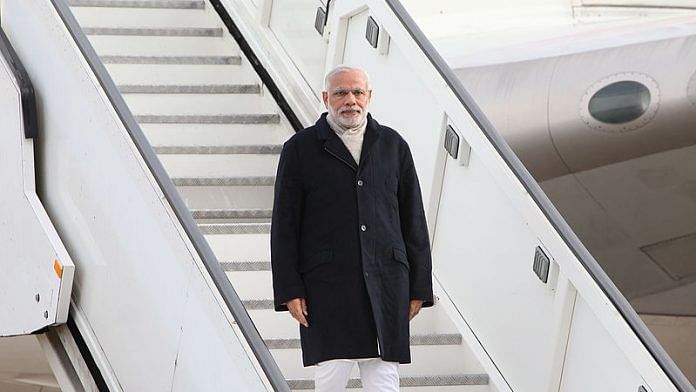For a government that was supposed to be business-friendly, the Modi administration has shown little or no understanding of what businesses actually want, as proved by the conditions set for AI sale.
When Narendra Modi took office as India’s Prime Minister just over four years ago, a top priority for the economic reformers who had supported his candidacy was the privatisation of India’s incredibly inefficient public sector. Among their biggest targets was the state-run airline, Air India – a clunky, loss-making behemoth that has long been rendered irrelevant by buzzy domestic competitors. I would personally have cheered that outcome: Air India has lost my luggage almost every time I’ve flown it internationally, and now I’m willing even to endure a 12-hour layover in Kiev or somewhere rather than fly direct to India on our proud “national carrier.” I’m not alone; Air India, once dominant, now has just 13 percent of the domestic market.
For the first few years of Modi’s tenure, as oil prices dropped and airlines all over the world began to head into the black, the government refused to even discuss privatising Air India. Then, after a prominent reformist was appointed as junior aviation minister, things slowly began to move. A few months ago, the airline was finally put up for sale. But last week, that process ended in the most humiliating manner possible for Air India and for the government: Not a single buyer came forward. The aviation ministry’s chief bureaucrat said that they were “certainly looking forward to better participation than this,” an assertion that reveals a most un-Indian gift for understatement.
The problem was, perhaps, the conditions that the government had attached to the sale. For one, it insisted that not a single worker could be fired for at least a year by the new owner. Air India is hopelessly overstaffed: It has 27,000 employees and is hiring even more. Of these, 11,214 are “permanent,” meaning that they’re protected by labor laws that are among the most inflexible in the world – government permission would be required to fire any of them. This huge workforce is also constantly making trouble, particularly the pilots. They tend to strike at a moment’s notice, encouraged historically by regulations that classified them alongside manual laborers, protecting their right to walk out. The legacy of a botched merger a decade ago means that workers don’t always get along, and are always eyeing each other’s benefits.
Naturally, any new owner would want to fire many of these people; after all, Air India managed to add to its losses even when its nimbler private competitors were happily making profits off of lower fuel prices. It is already $7.8 billion in debt – and the government has said that a buyer would have to take on at least two-thirds of that. These conditions, combined with Air India’s terrible reputation and continuing losses, mean that it might be too expensive even if it was given away for free.
If the government is serious about taking Air India off the books, it will have to meet bidders half-way. So far its approach isn’t promising. Any buyer would be far more interested in the airline’s landing rights and fleet of relatively new aircraft than in running it as-is, for instance. But the government wants the buyer to run it “at arms’ length” from its other businesses, preserving it as an independent airline. Moreover, foreign buyers are much more likely to be interested than domestic ones, yet the ruling party’s ideological parent, the Rashtriya Swayamsevak Sangh, detests foreign capital; its head has declared that India “must not cede control over its skies.”
Now, instead of accepting that it has simply not made the airline look attractive enough, the government is busy blaming everyone else – including the transaction advisers, whom it accuses of poor communication, and business in general for not wanting to take on a risky asset. For a government that was supposed to be business-friendly, the Modi administration has shown little or no understanding of what businesses actually want.
That’s been par for the course, in fact. Most major “privatisation” under Modi has been nothing of the sort – state-owned insurance companies have stepped up to buy shares of state-owned enterprises, for example, merely shifting resources around on the government’s balance sheet. If Modi wants to recover some of his reputation for being business-friendly as he prepares for a general election next year, then getting rid of Air India would be a good start – on whatever terms he can get.
-Bloomberg View







The views expressed in this article are correct even though I feel that the author has been a bit soft on modi. Its not just modi but his entire team which has zero capability. Witness the international debacle of “STREANH”. Its time modi stopped making a laughing stock of India around the world.
Current governance has signaled unfriendly towards businesses by imposing GST & aadhar acts without assessing dominating adverse impact of these two acts.
Air India was low hanging fruit. It ought to have been put on the block in the first year itself. The unexpected fall in oil prices would have given the process a little help. It is beyond the capabilities of a single efficient bureaucrat like Mr Lohani to turn it around. In fact, the government’s dominant view has been that there is nothing wrong in the public sector, per se, it just needs better management which it felt it had the capacity to provide. 2. One foresees a situation where this business will not get sold, even with fewer restrictions. The government might simply have to shut it down, pay off the employees, assume its humongous debt – which would never have reached this level if successive governments had not delayed the inevitable. Piecemeal disposal of its assets would reduce the size of the final write off.